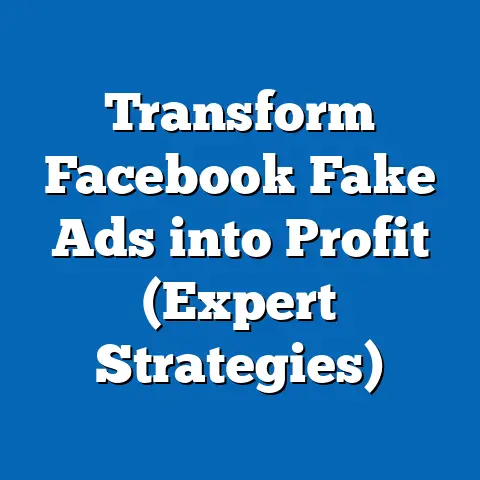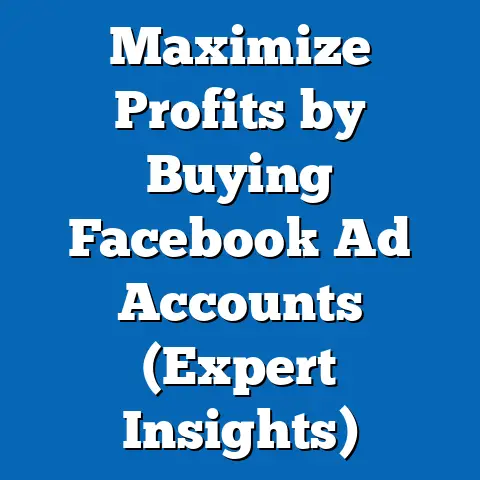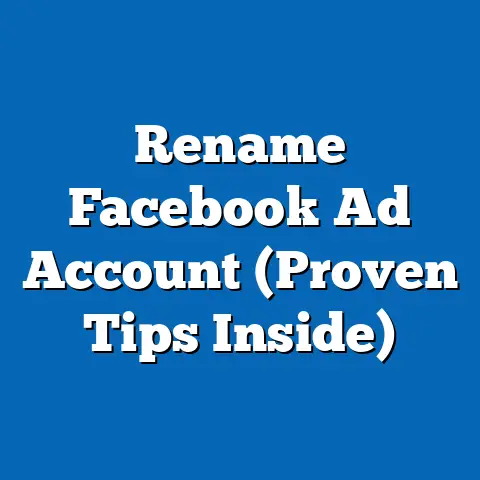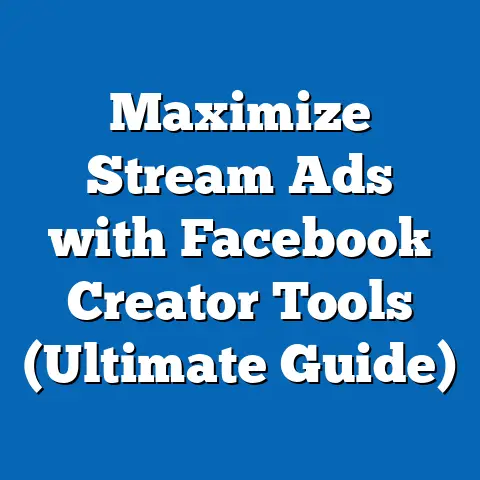Master Facebook Ads for Stellar Results (Ultimate Guide)
Are your Facebook Ads feeling more like a money pit than a lead-generating machine? Do you get lost in the labyrinth of options within Ads Manager, unsure which lever to pull to actually see results? Trust me, I’ve been there. I remember when I first started with Facebook Ads, I felt like I was throwing money into a black hole, hoping something would stick. I spent countless hours trying different strategies, sifting through data, and ultimately, learning what works and what doesn’t.
Mastering Facebook Ads isn’t just about having a budget; it’s about understanding the nuances of the platform, knowing your audience inside and out, and crafting compelling ads that convert. It’s about being strategic, analytical, and adaptable. This guide is designed to be your compass, leading you through the sometimes-turbulent waters of Facebook advertising. I’m going to share my insights, learned from years of experience and countless campaigns, to equip you with the tools and strategies you need to not just survive, but thrive, and achieve truly stellar results. Let’s dive in!
Understanding the Facebook Ads Ecosystem
Facebook, now part of Meta, is an absolute giant in the advertising world. With billions of active users, it offers unparalleled reach and the ability to target incredibly specific demographics and interests. That’s why understanding the Facebook Ads ecosystem is crucial for success. Think of it as learning the rules of the game before you even step onto the field.
The Facebook Ads structure is built around three core components:
- Campaigns: These are the overarching containers for your advertising efforts. They define your primary objective – what you want to achieve with your ads.
- Ad Sets: Within each campaign, you create Ad Sets. These define your target audience, budget, schedule, and ad placement. It’s where you fine-tune who sees your ads and when.
- Ads: Finally, the Ads are the actual creative content that your audience sees. This includes your images, videos, text, and call-to-action buttons.
Each component plays a vital role, and understanding how they interact is key to creating effective campaigns.
Then there’s the diverse landscape of ad formats. Facebook offers a range of options, including:
- Image Ads: These are simple, yet effective. A single image accompanied by text can be a great way to grab attention.
- Video Ads: Videos are incredibly engaging and can be used to tell a story, showcase a product, or provide valuable information.
- Carousel Ads: These allow you to display multiple images or videos in a single ad, making them perfect for showcasing a range of products or features.
- Slideshow Ads: Similar to video ads, slideshow ads use a series of images to create a dynamic and engaging experience.
Choosing the right ad format depends on your objective, target audience, and the message you want to convey.
At the heart of it all is the Facebook Ads Manager. This is your central hub for creating, managing, and analyzing your campaigns. It’s where you’ll set your budgets, define your audiences, create your ads, and track your results. Mastering the Ads Manager is essential for effective Facebook advertising.
Takeaway: The Facebook Ads ecosystem is a structured hierarchy, with Campaigns, Ad Sets, and Ads working together to achieve your advertising goals. The Ads Manager is your command center for managing all aspects of your campaigns.
Defining Your Objectives
Before you even think about creating an ad, you need to clearly define your objectives. What do you want to achieve with your Facebook Ads? Are you looking to raise brand awareness, generate leads, drive website traffic, or boost sales?
Facebook categorizes advertising objectives into three main categories:
- Awareness: These objectives are focused on reaching a broader audience and increasing brand recognition. Examples include Brand Awareness and Reach.
- Consideration: These objectives are designed to engage your audience and encourage them to learn more about your business. Examples include Traffic, Engagement, App Installs, Video Views, and Lead Generation.
- Conversion: These objectives are aimed at driving specific actions, such as purchases or sign-ups. Examples include Conversions, Catalog Sales, and Store Traffic.
It’s important to choose the right objective based on your overall business goals. For example, if you’re launching a new product, you might start with an Awareness campaign to build buzz and then transition to a Conversion campaign to drive sales.
Once you’ve defined your objective, you need to set measurable KPIs (Key Performance Indicators). These are the specific metrics that you’ll use to track your progress and measure the success of your campaigns. Examples of KPIs include:
- Website Traffic: The number of visitors to your website from your Facebook Ads.
- Lead Generation: The number of leads generated through your Facebook Ads.
- Sales: The number of sales generated through your Facebook Ads.
- Cost Per Acquisition (CPA): The cost of acquiring a new customer through your Facebook Ads.
- Return on Ad Spend (ROAS): The revenue generated for every dollar spent on Facebook Ads.
By setting measurable KPIs, you can track your performance, identify areas for improvement, and optimize your campaigns for better results.
Takeaway: Clearly define your advertising objectives and set measurable KPIs to track your progress and measure the success of your campaigns.
Audience Targeting Strategies
One of the most powerful features of Facebook Ads is its ability to target incredibly specific audiences. This allows you to reach the people who are most likely to be interested in your products or services.
Facebook offers a variety of audience targeting options, including:
- Demographic Targeting: Target users based on age, gender, location, education, job title, and other demographic factors. This is a great way to reach a broad audience based on basic characteristics.
- Interest-Based Targeting: Target users based on their interests, hobbies, and activities. This is a more targeted approach that allows you to reach people who are passionate about specific topics.
- Behavioral Targeting: Target users based on their online behavior, such as purchase history, website visits, and mobile device usage. This is a highly targeted approach that allows you to reach people who have demonstrated specific behaviors.
- Custom Audiences: Create custom audiences based on your existing customer data, such as email lists, website visitors, and app users. This is a powerful way to re-engage existing customers and reach people who have already shown an interest in your business.
- Lookalike Audiences: Create lookalike audiences based on your custom audiences. Facebook will find users who are similar to your existing customers, allowing you to reach a new audience that is likely to be interested in your products or services.
Creating buyer personas is a critical step in effective audience targeting. A buyer persona is a semi-fictional representation of your ideal customer. It’s based on research and data about your existing customers and potential customers. By creating buyer personas, you can gain a deeper understanding of your audience’s needs, pain points, and motivations.
Understanding your audience’s pain points is essential for crafting compelling ad copy and targeting the right people. What problems are they facing? What challenges are they trying to overcome? By addressing their pain points in your ads, you can capture their attention and demonstrate how your products or services can help them.
Finally, don’t underestimate the power of A/B testing in refining your audience targeting. Experiment with different targeting options to see which ones perform best. Try targeting different demographics, interests, and behaviors to see which audiences are most responsive to your ads.
I once ran a campaign for a local bakery, and initially, I targeted a broad audience within a 10-mile radius. The results were okay, but not great. Then, I decided to create a custom audience based on people who had visited the bakery’s website and engaged with their Facebook page. I also created a lookalike audience based on that custom audience. The results were phenomenal! The cost per acquisition dropped significantly, and the bakery saw a huge increase in sales.
Takeaway: Facebook’s audience targeting options are incredibly powerful. Take the time to understand your audience, create buyer personas, and experiment with different targeting options to find the ones that work best for you.
Crafting Compelling Ad Content
Even with the most precise targeting, your ads will fall flat if the content isn’t compelling. Think of your ad as a mini-sales pitch – you have a limited amount of time and space to grab attention, convey your message, and persuade your audience to take action.
The key elements of effective ad copy include:
- Headlines: Your headline is the first thing people will see, so it needs to be attention-grabbing and relevant. Use strong verbs, ask a question, or make a bold statement.
- Body Text: Your body text should provide more detail about your product or service and explain how it can benefit your audience. Focus on the value you offer and address their pain points.
- Calls-to-Action (CTAs): Your CTA tells people what you want them to do next. Use clear and concise language, such as “Learn More,” “Shop Now,” or “Sign Up.”
Visual content is equally important. Eye-catching images and videos can make a huge difference in the performance of your ads.
- Use high-quality images that are relevant to your product or service.
- Create videos that are engaging, informative, and visually appealing.
- Consider using bright colors and bold graphics to grab attention.
Storytelling is a powerful tool for engaging viewers and driving conversions. Tell a story that resonates with your audience and connects with their emotions.
- Share customer testimonials or case studies.
- Showcase the benefits of your product or service in a relatable way.
- Create a narrative that draws viewers in and makes them want to learn more.
I remember working with a client who sold handmade jewelry. Their initial ads featured simple product photos with generic descriptions. The results were underwhelming. We decided to create a video ad that told the story of how the jewelry was made, highlighting the craftsmanship and the passion that went into each piece. The video resonated with viewers, and the client saw a significant increase in sales.
Takeaway: Craft compelling ad copy, use eye-catching visuals, and tell stories that resonate with your audience to drive engagement and conversions.
Setting Your Budget and Bidding Strategies
Setting the right budget and choosing the right bidding strategy are crucial for maximizing your return on investment.
Facebook offers two main budgeting options:
- Daily Budgets: You set a specific amount that you’re willing to spend each day. This is a good option if you want to control your spending on a daily basis.
- Lifetime Budgets: You set a specific amount that you’re willing to spend over the entire duration of your campaign. This is a good option if you want to control your overall spending and let Facebook optimize your budget allocation.
Choosing the right budgeting option depends on your goals and your level of control.
Facebook also offers two main bidding strategies:
- Automatic Bidding: Facebook automatically sets your bids to get you the most results for your budget. This is a good option if you’re new to Facebook Ads or if you want to save time and effort.
- Manual Bidding: You manually set your bids for each ad set. This is a good option if you want more control over your bidding and if you have a good understanding of the Facebook Ads auction system.
The Facebook Ads auction system is a complex algorithm that determines which ads are shown to which users. Understanding how the auction system works can help you optimize your bids and improve your ad performance.
- Facebook takes into account your bid, your ad quality, and the estimated action rate (the likelihood that a user will take the desired action) to determine which ads to show.
- By improving your ad quality and increasing your estimated action rate, you can improve your chances of winning the auction and getting your ads shown to more people.
Takeaway: Choose the right budgeting option and bidding strategy based on your goals and your level of control. Understanding the Facebook Ads auction system can help you optimize your bids and improve your ad performance.
Analyzing and Optimizing Your Campaigns
The final step in mastering Facebook Ads is analyzing your results and optimizing your campaigns for better performance.
There are several key metrics to track, including:
- Click-Through Rate (CTR): The percentage of people who click on your ad after seeing it. A high CTR indicates that your ad is relevant and engaging.
- Cost Per Click (CPC): The average cost you pay each time someone clicks on your ad. A low CPC indicates that your bidding strategy is effective.
- Cost Per Acquisition (CPA): The cost of acquiring a new customer through your Facebook Ads. A low CPA indicates that your campaigns are efficient and effective.
- Return on Ad Spend (ROAS): The revenue generated for every dollar spent on Facebook Ads. A high ROAS indicates that your campaigns are generating a good return on investment.
Facebook Analytics and Ads Manager are powerful tools for evaluating your performance.
- Use Facebook Analytics to track website traffic, user behavior, and conversions.
- Use Ads Manager to track ad performance, budget allocation, and audience targeting.
Ongoing optimization is essential for improving your results.
- Make data-driven adjustments to your targeting, ad creative, and budget allocation.
- Experiment with different ad formats and bidding strategies.
- Continuously monitor your results and make adjustments as needed.
I once had a campaign that was performing well initially, but then the results started to decline. I analyzed the data and discovered that the audience was becoming saturated with my ads. I decided to expand the targeting to include a new group of users, and the results immediately improved.
Takeaway: Track your key metrics, use Facebook Analytics and Ads Manager to evaluate your performance, and make data-driven adjustments to your campaigns to improve your results.
Taking Action for Stellar Results
You’ve now journeyed through the essential elements of mastering Facebook Ads. From understanding the ecosystem to defining your objectives, targeting your audience, crafting compelling content, managing your budget, and analyzing your results, you’re equipped with the knowledge to create effective campaigns.
But knowledge alone isn’t enough. The real magic happens when you take action and implement what you’ve learned. Mastering Facebook Ads is an ongoing process that requires experimentation, adaptation, and a willingness to learn from your mistakes.
Don’t be afraid to try new things, test different strategies, and push the boundaries of your creativity. The more you experiment, the more you’ll learn about what works best for your business.
So, what are you waiting for? Put this ultimate guide into action and strive for stellar results in your advertising efforts. The world of Facebook Ads is constantly evolving, but with a solid foundation and a commitment to continuous improvement, you can achieve your advertising goals and grow your business.
And remember, I’m here to help! Feel free to share your experiences, ask questions, or even just brainstorm ideas in the comments below. Let’s learn and grow together in the ever-evolving world of Facebook advertising. You can also subscribe to my newsletter for more tips and resources on digital marketing and advertising strategies. Now go out there and create some stellar ads!






